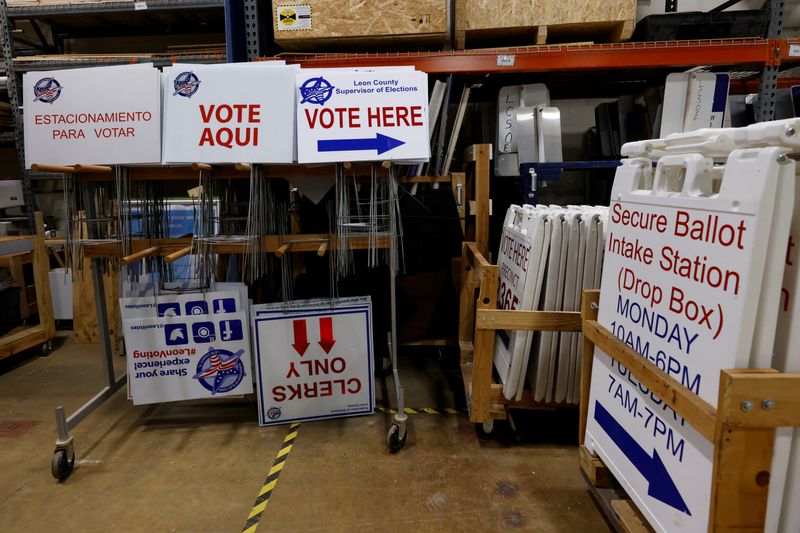By Matt Zdun
(Reuters) - Misinformation online and false claims of election fraud by former President Donald Trump and his allies have sharply eroded public trust in the integrity of U.S. elections. How Americans vote — and the equipment they use — varies widely, and some methods are more vulnerable to efforts to shake that trust.
Heading into the 2022 midterms, election experts say the move in most states to hybrid voting systems – paper ballots tallied by electronic machines – could give voters greater confidence.
ELECTRONIC VOTING MACHINES
The United States invested hugely in paperless electronic voting machines after the contested presidential election between Democrat Al Gore and Republican George W. Bush in 2000 shook election officials’ confidence in paper ballots.
By 2006, the share of registered voters using paperless machines had surged, though hand-marked paper ballots that are later scanned by electronic tabulators remained the most popular. For the next decade, about a third of all votes were cast on direct recording electronic machines.
These electronic voting machines store the votes in their memory. The lack of a physical record to back up the electronic vote means election officials must trust that the machines do not malfunction and change or lose a vote, that poll workers do not inadvertently alter votes, or that the machines are not hacked, said Douglas Jones, a retired University of Iowa computer science professor who spent decades studying the use of computers in elections.
In 2016 about 22% of registered voters were living in jurisdictions that used electronic voting machines without paper trails, according to data from Verified Voting, a U.S. nonprofit that promotes the use of secure technology in election administration.
By 2020 fewer than 9% of registered voters nationwide were living in jurisdictions that used electronic voting machines without paper trails for all voters — the smallest number since data was first available in 2006. This shift reflected election officials’ growing concerns about foreign interference in elections and the need to have some way to audit tallies.
For the November midterms, that number is expected to dwindle to about 5%, according to data from Verified Voting.
Counties in six states still use paperless voting machines. Most lie in solidly Republican or Democratic congressional districts, which decreases the likelihood of a contested election.
However, there are six congressional districts that are considered at least somewhat competitive and are using electronic voting machines without paper records: the second, third, fifth and seventh districts in New Jersey; Indiana’s first district; and Texas’s 15th district.
PAPER BALLOTS
The United States, like many countries, mostly uses paper ballots to vote. Nearly 70% of registered voters live in jurisdictions that primarily use hand-marked paper ballots, according to data from Verified Voting.
About 23% of registered voters live in jurisdictions that primarily use machines called ballot-marking devices. These allow voters to make their selections electronically and also produce a paper record that can be scanned by another device.
The extent to which voters use digital technology to cast their ballots has shifted over time. Paperless electronic voting, touted for its ability to tally votes quickly and accurately, largely decreased in popularity in the United States and European countries from the mid-2000s onward.
Countries have turned to paper as the most secure way to audit their elections and detect potential vote tampering. To be sure, machines are still integral to the election process even when votes are cast on paper ballots. Optical scan tabulators count the results.
Election experts say paper ballots help to secure elections because they allow voters to verify how they voted and officials to cross-check results in post-election audits.
Georgia illustrates the importance of having a paper voting trail. The state had used paperless voting machines for several years. But just before the 2020 presidential election, it replaced its equipment with ballot marking devices, the machines in which voters make their selections electronically and can then review them on a printed paper ballot, which is then scanned and tabulated by a different machine.
Trump challenged the results and falsely claims that there were widespread irregularities and fraud in states that he lost to his Democratic opponent Joe Biden. Because there were paper ballots, however, election officials in Georgia were able to hand-count the votes and confirm Biden had indeed won the state.
VOTE-TABULATING SYSTEMS
The push toward paper does not mean that machines are disappearing from voting places. Almost all still use machines to tabulate the paper ballots. Trump and his allies falsely claim that tabulators in some 2020 races were manipulated to flip votes from Trump to Biden.

They are pushing for the machines to be ditched entirely and for the ballots to be counted by hand, which election officials say is a logistical non-starter. The claims have been thoroughly investigated and debunked.
Still, claims of election fraud have sown widespread mistrust in elections, with an ABC/Ipsos poll in January finding only about 20% of the American public is very confident in the election system.